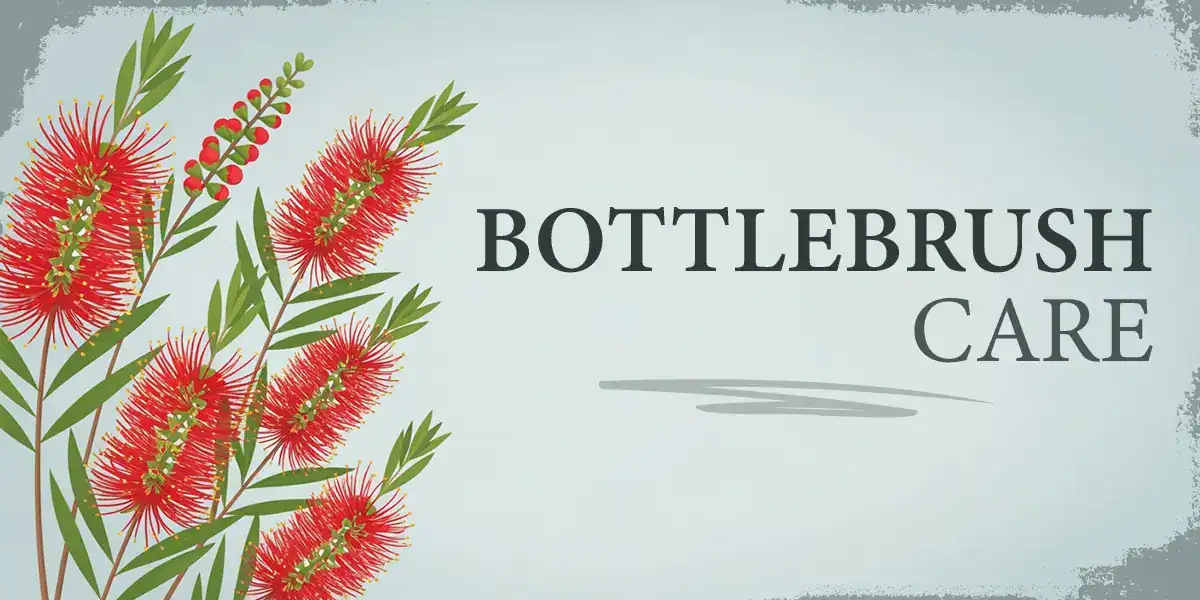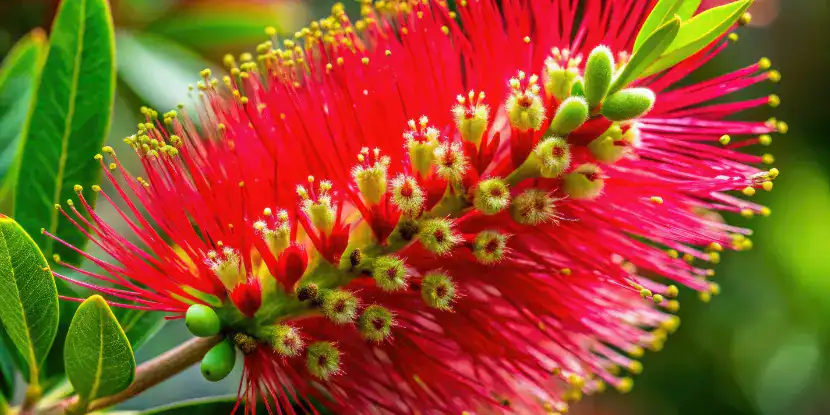The oddly beautiful bottlebrush plant comes from Australia, a land of bizarre creatures like the platypus and leafy sea dragon. Its cylindrical, long-blooming flowers resemble, well, a brush to clean bottles.
The flower’s bright red “bristles” are actually stamens — the pollen-bearing part of the flower. Petals are tiny and often fall off quickly.
European explorers brought bottlebrush seeds to Southern California in the 1800s. The plants adapted so well to the Mediterranean climate that they’ve become a staple in water-wise landscaping throughout the region.
Why Bottlebrush Is “Bonza” for Southern California
- Once established, bottlebrush plants need minimal water.
- Their thick bark and ability to regenerate from the base make bottlebrush fire-resistant.
- Bottlebrush can bloom from spring through fall in Southern California’s mild climate.
- The nectar-rich flowers attract hummingbirds, butterflies, and beneficial insects to your garden.
- The plants require little pruning and fertilizing.
Growth Habit
Bottlebrush (genus Callistemon or more recently Melaleuca) exhibits the following growth habits:
- Bottlebrush can grow as either a large shrub or a small tree, depending on the species and cultivation conditions.
- Most common species often form dense, multi-stemmed shrubs ranging from 3 to 15 feet tall. Some varieties can grow into small weeping trees up to 20–25 feet tall.
- Plants are evergreen, keeping their slender, pointed leaves year-round.
- The growth form may be upright and bushy or arching and weeping, especially in cultivars bred for ornamental landscapes.
Bottlebrush Flower Colors
- Red: The classic and most common color.
- Pink: Varieties like Callistemon ‘Pink Champagne’ offer soft pink tones.
- Crimson/Deep Red: A deeper variation of the classic red, found in several cultivars.
- Lemon Yellow: Callistemon pallidus and others can produce pale yellow or creamy flowers.
- Greenish or Lime Yellow: Some hybrids and species bear chartreuse-toned blooms.
- White: Rare but available in select cultivars, often with subtle hints of cream.
These color variations are enhanced by breeding and are particularly attractive to pollinators like hummingbirds and bees.
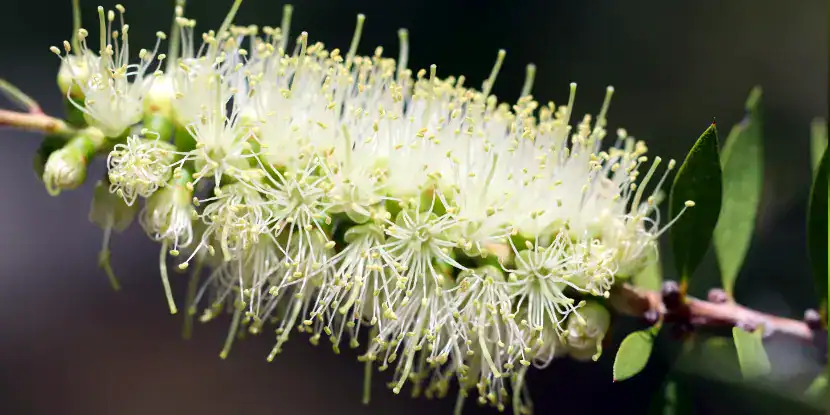
White bottlebush blooms are rare but available to the persistent gardener.
Propagating Bottlebrush
You can grow bottlebrush from seeds or cuttings. Cuttings produce faster results.
From cuttings: Take 4-6-inch semi-hardwood cuttings in late spring or early summer. Remove the lower leaves and dip the cut end in rooting hormone. Plant in a well-draining potting mix and keep consistently moist until roots develop in 6-8 weeks.
From seeds: Collect seeds from dried flower spikes in fall. Plant in seed-starting mix and keep warm and moist. Germination takes 2-4 weeks, but seedlings grow slowly and may not flower for several years.
Optimal Growing Conditions
Light
Bottlebrush plants perform best in at least 6-8 hours of direct sunlight daily. They tolerate partial shade but will produce fewer flowers and develop a more open growth habit.
In Southern California’s intense summer heat, plants benefit from some afternoon shade in desert regions. Coastal areas offer ideal conditions with bright morning sun and afternoon protection.
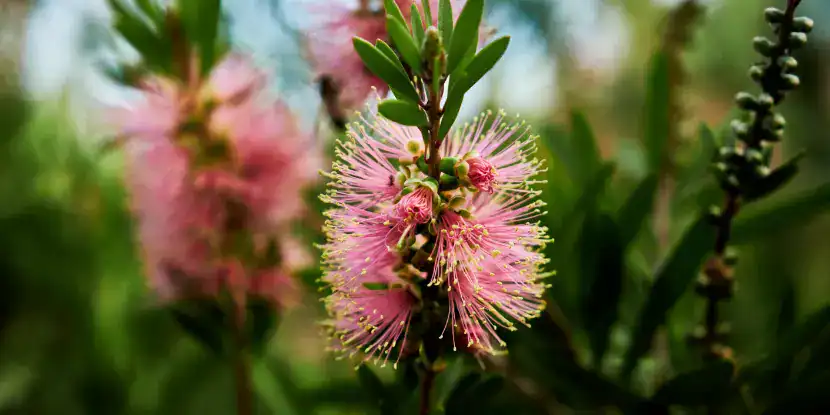
A delicate pink bottlebush bloom.
Temperature Tolerance
Most bottlebrush varieties are hardy in USDA zones 9-11, making them perfect for Southern California’s climate. They can withstand temperatures down to 20°F once established, though young plants need protection from frost.
The plants benefit from Southern California’s mild winters, which provide a natural rest period without the extreme cold that can damage other flowering shrubs.
Soil
Bottlebrush plants adapt to various soil types but perform best in well-draining soil with a pH between 6.0 and 7.5. They struggle in heavy clay or waterlogged conditions.
Amend heavy soils with compost or coarse sand to improve drainage. These plants tolerate poor, rocky soil better than rich, moisture-retentive soil.
Steps for Planting Bottlebrush
- Select a spot with full sun and good air circulation. Ensure there’s space for the mature size — most varieties reach 6–15 feet tall and wide.
- Dig a hole twice as wide as the root ball but only as deep. If your soil is sandy or clay-heavy, mix in compost.
- Position the plant so the top of the root ball is level with the surrounding soil. Planting too deep can cause root rot.
- Water thoroughly to settle the soil around the roots.
- Spread 2–3 inches of organic mulch around the base, keeping it away from the trunk to prevent pest problems.
- Large plants or those in windy locations may need temporary staking for the first year.
Bottlebrush Care
Watering Requirements
- Water newly planted bottlebrush deeply once or twice a week for the first year, allowing the soil to dry between waterings.
- Once established, plants are extremely drought-tolerant. In Southern California, mature bottlebrush needs supplemental watering only during drought or extreme heat waves.
- Overwatering is more harmful than underwatering. Signs of overwatering include yellowing leaves, root rot, and reduced flowering.
Fertilizing Guidelines
- A balanced, slow-release fertilizer applied in early spring is adequate for the growing season.
- Avoid high-nitrogen fertilizers, which promote excessive leaf growth at the expense of flowers. Phosphorus-rich fertilizers can harm these plants in Southern California’s alkaline soils.
- Organic options like compost or aged manure work well as soil amendments and provide gentle, long-lasting nutrition.
Pests & Diseases
Pest or disease problems in Southern California are uncommon. Still, watch for:
- Scale insects: These small, brown bumps on stems and leaves can weaken plants. Treat with horticultural oil or insecticidal soap.
- Spider mites: Hot, dry conditions can encourage spider mite infestations. Increase humidity around plants and use predatory mites for biological control.
- Root rot: Overwatering or poor drainage can cause root rot. Improve drainage and reduce watering frequency.
- Powdery mildew: This fungal disease appears as white, powdery leaf patches. Improve air circulation and avoid overhead watering.
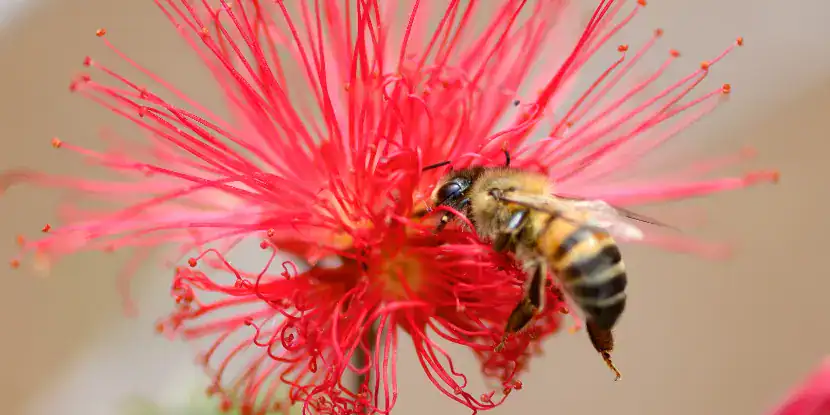
Plant a bottlebrush today, and the bees will thank you later.
Pruning Techniques
Strategic cuts can improve the shape and flowering of bottlebrush plants.
- Timing: Prune immediately after flowering to avoid removing next year’s flower buds.
- Light pruning: Remove spent flowers and any dead, damaged, or crossing branches throughout the year.
- Rejuvenation pruning: Older plants can be cut back by one-third to encourage new growth and a more compact shape.
- Avoid heavy pruning: Bottlebrush plants don’t respond well to extensive pruning and may not recover fully.
Container Gardening
These highly adaptable shrubs also flourish in containers, making them perfect for small spaces or areas with limited garden beds. Thanks to their woody stems and tolerance for shaping, they can also grow as bonsai trees.
- Choose a container at least two times the size of the root ball to allow room for growth.
- Use well-draining potting soil with a slightly acidic pH (around 6.0-6.5).
- Container-grown plants may require more frequent watering. Monitor moisture levels and water when the top inch of soil feels dry.
- Feed once monthly with a balanced fertilizer during summer.
- Prune regularly to control growth and maintain the desired shape.
Additional Care Tips
- Maintain a 2-3 inch layer of organic mulch to conserve moisture and suppress weeds. Refresh mulch annually.
- Young plants benefit from windbreaks in exposed locations until they develop strong root systems.
- Pair bottlebrush with other drought-tolerant plants like lavender, rosemary, and native California plants for a cohesive, water-wise landscape.
- Remove any frost-damaged growth in late winter before new growth begins.
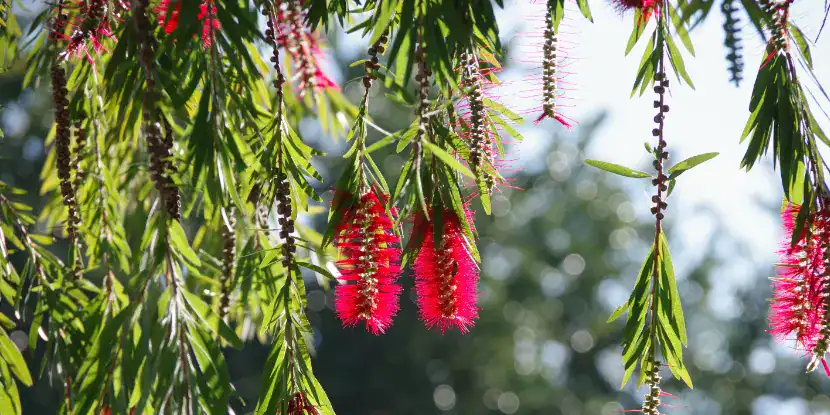
The weeping habit of a bottlebrush tree.
FAQs: Bottlebrush Care
Q: How fast do bottlebrush plants grow?
Bottlebrush plants are moderate to fast growers, typically adding 1–2 feet per year once established. Growth rate depends on variety, growing conditions, and care.
Q: Can bottlebrush plants survive frost?
Once established, most bottlebrush varieties tolerate light frost, but young plants need protection. Cover with frost cloth when temperatures drop below 25°F.
Q: Why isn’t my bottlebrush flowering?
Common causes include lack of sunlight, over-fertilizing with nitrogen, or pruning at the wrong time. Ensure full sun exposure and avoid pruning from fall through early spring.
Q: How often should I water established bottlebrush plants?
In Southern California, established bottlebrush typically needs deep watering every 2–3 weeks during summer, less frequently in winter. Adjust according to rainfall and soil conditions.
Q: Can I grow bottlebrush in containers?
Dwarf varieties work well in large containers. They require more frequent watering and well-draining potting mix than ground-planted specimens. Choose containers at least 24 inches wide.
Q: When is the best time to plant bottlebrush?
Plant bottlebrush in fall or early spring in Southern California. This gives plants time to establish before extreme summer heat or winter cold.
Q: How do I encourage more flowers on my bottlebrush?
Ensure full sun exposure, avoid excess nitrogen fertilizer, and prune only after flowering. Phosphorus can help flowering, but use sparingly in alkaline soils.
Q: Are bottlebrush plants deer resistant?
Bottlebrush plants are generally deer-resistant due to their aromatic foliage and tough leaves. However, ravenous deer may browse young, tender growth.

